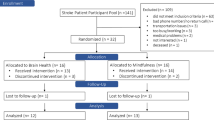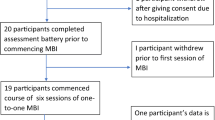Abstract
The overall purpose of this study was to pilot a multibehavioral, brief, stroke self-care treatment adapted for implementation with underserved racial/ethnic minority groups and to test the moderating effects of anxiety and depression on engagement in secondary stroke-prevention behaviors. Fifty-two participants were randomized to the secondary stroke prevention (STOP) (N = 27) or usual care (N = 25) group. The STOP program consisted of 3 culturally tailored information sessions and goal-setting activities that were delivered in person by a research assistant. Participants were assessed at baseline and 4-week follow-up for stroke knowledge, exercise, fruit and vegetable consumption, tobacco and alcohol use, and medication adherence (primary outcomes) and anxiety and depression (moderator variables). Between-groups analysis of covariance and logistic multiple regressions revealed significant between-group differences for stroke knowledge, tobacco use and moderating effects between tobacco and anxiety, and improved alcohol use. The STOP program decreased secondary stroke risk factors among underserved racial/ethnic minorities and should be tested in large-scale trials.

Similar content being viewed by others
References
Ahluwala, J. S., Dang, K. S., Choi, W. S., & Harris, K. J. (2002). Smoking behaviors and regular source of health care among African Americans. Preventive Medicine, 34, 393–396.
American Heart Association. (2004). Heart disease and stroke statistics—2005 update. Dallas, TX: American Heart Association, 2004.
Appelros, P., Nydevik, I., & Viitanen, M. (2003). Poor outcome after first-ever stroke: Predictors for death, dependency, and recurrent stroke within the first year. Stroke, 34, 122–126.
Charbonneau, A., Rosen, A. K., Ash, A. S., Owen, R. R., Kader, B., & Spiro, A., I. I. I. (2003). Measuring the quality of depression care in a large integrated health system. Medical Care, 41, 669–680.
Clark, A. N., Sander, A. M., Pappadis, M. R., Evans, G. L., Truchen, M. A., & Chious-Tan, F. Y. (2010). Caregiver characteristics and their relationship to health service utilization in minority patients with first episode stroke. NeuroRehabilitation, 27, 95–104.
Collins, B. N., & Lepore, S. J. (2009). Association between anxiety and smoking in a sample of urban black men. Journal of Immigrant and Minority Health, 11, 29–34.
Covington, C. F., Kin, J. A., Fennell, I., Jones, C., Hutchinson, C., & Evans, A. (2010). Developing a community-based stroke prevention intervention course in minority communities: The DC Angels Project. Journal of Neuroscience Nursing, 42, 139–142.
De Wit, L., Putman, K., Baert, I., Lincoln, N. B., Angst, F., & Beyens, H. (2008). Anxiety and depression in the first six months after stroke. A longitudinal multicentre study. Disability and Rehabilitation, 30, 1858–1866.
Derogatis, L. R. (1992). BSI: Administration, scoring and procedures manual-II. Towson, MD: Clinical Psychometric Research.
Donnellan, C., Hickey, A., Hevey, D., & O’Neill, D. (2010). Effect of mood symptoms on recovery one year after stroke. International Journal of Geriatric Psychiatry, 25, 1288–1295.
Eriksson, M., Asplund, K., Glader, E. L., Norrving, B., Stegmayr, B., Terént, A., et al. (2004). Riks-stroke collaboration. Self-reported depression and use of antidepressants after stroke: A national survey. Stroke, 35, 936–941.
Folstein, M. F., Folstein, S. E., & McHugh, P. R. (1975). “Mini-mental state”. A practical method for grading the cognitive state of patients for the clinician. Journal of Psychiatric Research, 12, 189–198.
Furie, K. L., Kasner, S. E., Adams, R. J., Albers, G. W., Bush, R. L., & Fagan, S. (2011). Guidelines for the prevention of stroke in patients with stroke or transient ischemic attack. A guideline for healthcare professionals from the American Heart Association/American Stroke Association. Stroke, 42, 227–276.
Ghose, S. S., William, L. S., & Swindle, R. W. (2005). Depression and other mental health diagnoses after stroke increase inpatient and outpatient medical utilization three years post stroke. Medical Care, 43, 1259–1264.
Giles, W. H., Tucker, P., Brown, L., et al. (2004). Racial and ethnic approaches to community health (REACH 2010): An overview. Ethnicity and Disease, 14, S5–S8.
Gillham, S., & Endacott, R. (2010). Impact of enhanced secondary prevention on health behaviour in patients following minor stroke and transient ischaemic attack: A randomized controlled trial. Clinical Rehabilitation, 24, 822–830.
Hackett, M. L., & Anderson, C. S. (2005). Predictors of depression after stroke: A systematic review of observational studies. Stroke, 36, 2296–2301.
Hankey, G. J., Jamrozik, K., Broadhurst, R. J., Forbes, S., & Anderson, C. S. (2002). Long-term disability after first-ever stroke and related prognostic factors in the Perth community Stroke Study, 1989–90. Stroke, 33, 1034–1040.
Havas, S., Anliker, J., Greenberg, D., Block, G., & Block, T. (2003). Final results of the Maryland WIC Food for Life program. Preventive Medicine, 37, 406–416.
Jia, H., Chumbler, N. R., Wang, X., Chuang, H. C., Damush, T. M., Cameon, R., et al. (2010). Racial and ethnicity disparities in post-stroke depression detection. International Journal of Geriatric Psychiatry, 25, 298–304.
Kahn, D. R., Bourgeois, J. A., Klein, S. C., & Iosif, A. M. (2009). A prospective observational study of decisional capacity determinations in an academic medical center. International Journal of Psychiatry Medicine, 39, 405–415.
Keller, C. S., Gonzalaes, A., & Fleuriet, K. J. (2005). Retention of minority participants in clinical research studies. Western Journal of Nursing Research, 27, 292–306.
Kreuter, M. W., Skinner, C. S., Holt, C. L., Clark, E. M., Haire-Joshu, D., & Fu, Q. (2005). Cultural tailoring for mammography and fruit and vegetable intake among low-income African American women in urban public health centers. Preventive Medicine, 41, 53–62.
Lawrence, M., Kerr, S., McVey, C., & Godwin, J. (2012). The effectiveness of secondary prevention lifestyle interventions designed to change lifestyle behavior following stroke: Summary of a systematic review. International Journal of Stroke, 7, 243–247.
Levine, D. A., Kiefe, C. I., Howard, G., Howard, V. J., Williams, O. D., & Allison, J. J. (2007). Reduced medication access: A marker for vulnerability in US stroke survivors. Stroke, 38, 1557–1564.
Liao, Y., Bang, D., Brosgrove, S., Dulin, R., Harris, Z., Stewart, A. (2011). Surveillance of health status in minority communities—racial and ethnic approaches to community health across the U.S. (REACH U.S.) risk factor survey, United States, 2009. Center for Disease Control and Prevention Morbidity and Mortality Weekly Report, Surveillance Summaries, 60, 1–42.
LLohse, B., Stotts, J. L., & Bagdonis, J. (2006). Income sub stratification within a low income sample denotes dropout and completion patterns in nutrition education intervention for young adults. The FASEB Journal, 20, A1312.
Lutfiyya, M. N., Ng, L., Asner, N., & Lipsky, M. S. (2009). Disparities in stroke symptomology knowledge among US midlife women: An analysis of population survey data. Journal of Stroke & Cerebrovascular Disease, 18, 150–157.
Mead, G. E., Greig, C. A., Cunningham, I., Lewis, S. J., Dinan, S., & Saunders, D. H. (2007). Stroke: A randomized trial of exercise or relaxation. Journal of the American Geriatric Society, 55, 892–899.
Modrego, P. J., Mainar, R., & Turull, L. (2004). Recurrence and survival after first-ever stroke in the area of Bajo Aragon, Spain. A prospective cohort study. Journal of the Neurological Sciences, 224, 49–55.
Morgenstern, L. B., Smith, M. A., Lisabeth, L. D., Risser, J. M., Uchino, K., & Garcia, N. (2004). Excess stroke in Mexican Americans compared with non-Hispanic Whites: The brain attack surveillance in Corpus Christi Project. American Journal of Epidemiology, 2004, 376–383.
Ovbiagele, B., Saver, J. L., Fredieu, A., Suzuki, S., Selco, S., & Rajajee, V. (2004). In-hospital initiation of secondary stroke prevention therapies yields high rates of adherence at follow-up. Stroke, 35, 2879–2883.
Pearson, T. A., Blair, S. N., Daniels, S. R., Eckel, R. H., Fair, J. M., & Fortmann, S. P. (2002). AHA Guidelines for primary prevention of cardiovascular disease and stroke: 2002 update: Consensus panel guide to comprehensive risk deduction for adult patients without coronary or other atherosclerotic vascular diseases. American Heart Association Science Advisory and Coordinating Committee. Circulation, 106, 388–391.
Pratt, C. A., Ha, L., Levine, S., & Pratt, C. B. (2003). Stroke knowledge and barriers to stroke prevention among African Americans: Implications for health communication. Journal of Health Communications, 8, 369–381.
Robinson, R. G. (2003). Predictors of depression after stroke: A systematic review of observational studies. Biological Psychiatry, 45, 376–387.
Roby, D. H., Nicholson, G. H., & Kominski, G. F. (2009). African Americans in commercial HMOs more likely to delay prescription drugs and use the emergency room. Policy Brief/UCLA Center for Health Policy Research, Dec(PB2009-11), 1–12.
Shacham, E., Basta, T. B., Reece, M. (2008). Symptoms of psychological distress among African Americans seeking HIV-related mental health care.
Sit, J. W., Yip, V. Y., Ko, S. K., Gun, A. P., & Lee, J. S. (2007). A quasi-experimental study on a community-based stroke prevention programme for clients with minor stroke. Journal of Clinical Nursing, 16, 272–281.
US Centers for Disease Control and Prevention. (2004). US Behavioral surveillance survey. Atlanta, GA: Author.
Whitlock, E. P., Orleans, C. T., Pender, N., & Allan, J. (2002). Evaluating primary care behavioral counseling interventions: An evidence-based approach. American Journal of Preventive Medicine, 22, 267–284.
Williams, L. S., Ghose, S. S., & Swindle, R. W. (2004). Depression and other mental health diagnosis increase mortality risk after ischemic stroke. American Journal of Psychiatry, 161, 1090–1095.
Yore, M. M., Ham, S. A., Ainsworth, B. E., Kruger, J., Reis, J. P., Kohon, H. W., I. I. I., et al. (2007). Reliability and validity of the instrument used in BRFSS to assess physical activity. Medicine and Science in Sports and Exercise, 39, 1267–1274.
Zahuranec, D. B., Morgenstern, L. B., Garcia, N. M., Conley, K. M., Lisabeth, L. D., Rank, G. S., et al. (2008). Stroke health and risk education (SHARE) pilot project: Feasibility and need for church-based stroke health promotion in a bi-ethnic community. Stroke, 39, 1583–1585.
Acknowledgments
This work was supported by NIDDR fellowship grant #H133P020003 (training future investigators projects) from the National Institute on Disability and Rehabilitation Research to Dr. Diana Rintalla. This work was also partly supported by the VA HSR&D Houston Center of Excellence (HFP90-020) and the VA South Central (VISN 16) Mental Illness Research, Education, and Clinical Center. The views expressed reflect those of the authors and not necessarily those of the NIDDR, the National Institutes of Health, the Department of Veterans Affairs, the US government or Baylor College of Medicine. The NIDDR had no role in the design and conduct of the study; the collection, management, analysis and interpretation of the data; or the preparation, review or approval of the manuscript. The authors had/have full control of all primary data and agree to allow review of data if required.
Conflict of interest
The authors report no financial conflicts of interest.
Author information
Authors and Affiliations
Corresponding author
Rights and permissions
About this article
Cite this article
Evans-Hudnall, G.L., Stanley, M.A., Clark, A.N. et al. Improving secondary stroke self-care among underserved ethnic minority individuals: a randomized clinical trial of a pilot intervention. J Behav Med 37, 196–204 (2014). https://doi.org/10.1007/s10865-012-9469-2
Received:
Accepted:
Published:
Issue Date:
DOI: https://doi.org/10.1007/s10865-012-9469-2




